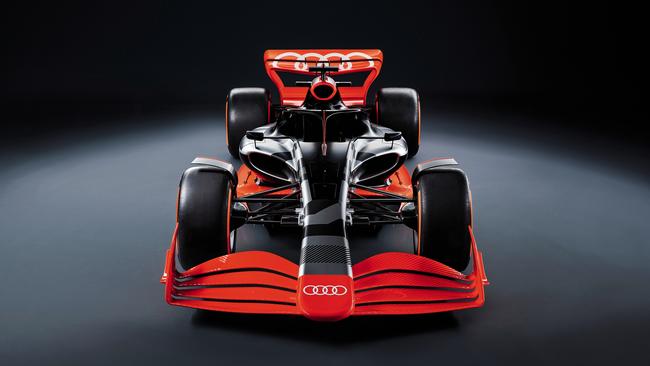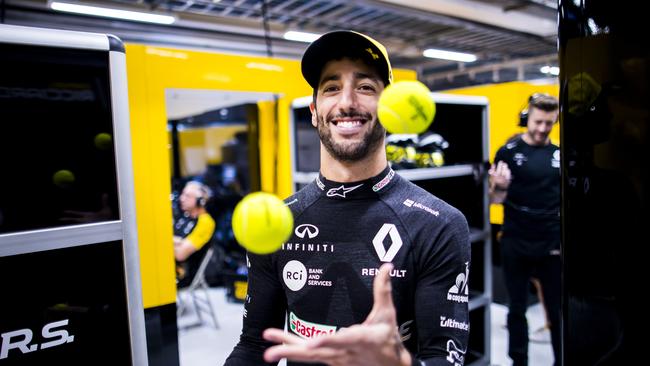Audi joins the greatest show on wheels
Audi’s announcement that it will enter Formula One, for the first time ever in 2026, is quite the surprise.

While there’s little doubt that Netflix is causing us all to spend more time devolving into couch vegetables and ruining our physical and mental health, it has, at least, made me more interesting at parties.
In the past, when I mentioned that I was a Formula One fan, people’s eyes would glaze over so fast you’d swear I’d cooked toffee on them, but now, thanks to Netflix’s phenomenally successful Drive to Survive series, I’m greeted as a fellow traveller.
And then I quickly become a guru-like centre of attention when I mention that, for work, I’ve visited the Mercedes-AMG F1 facility where I learned that, in long sweeping corners, Lewis Hamilton’s head effectively weights 25kg, thanks to G-forces, or about the same as an eight-year-old child.
If he didn’t work so hard on his neck strength, constantly, his head would probably fly off. (When he first came into F1 racing, in 2007, Lewis had a 14-inch collar size, today he’s got an 18-inch collar.)

And that, at the time, some part of the Mercedes racing car was being updated, or redesigned, on average, every 20 minutes, 24 hours a day. Over the course of a season, an F1 car will get two seconds a lap faster. Fail to keep up with that speed of development and you fall behind in this most ferociously competitive – and expensive – form of sport.
It is only the bravest, and best-funded, car companies that would dare to tackle this crucible of high tech and high speed, and history is littered with those who have tried and failed. So Audi’s announcement that it will enter Formula One, for the first time ever in 2026, was quite a surprise.
Officially, the decision is all about the exciting opportunities for technology transfer once F1 turns towards an even more hybrid-based, electric-powered set of rules in that same year, but you have to wonder if some high-level Audi bosses have been bingeing Drive to Survive.
Entering F1 isn’t as easy as just turning up, of course, and Audi has had to take a stake in an existing team, Sauber, which is currently racing under the Alfa Romeo brand and using Ferrari engines. (I also visited the Sauber factory some years ago, where an engineer explained to me that the best form of ballast – weight put into parts of the car for better stability – he had found was depleted uranium, but that it was “quite expensive”.)
Engineers in Germany are already working hard on the V6 engines it will provide when Sauber becomes the official Audi factory team in 2026. Oliver Hoffmann, Audi’s head of F1 technical development, said it was vital to start refining the technology now because three years would be barely enough time to catch up with existing teams. “Otherwise, the competitors have so much knowledge from their history, it‘s not possible to enter as a newcomer,” he said.
Audi does have a long history of success in other forms of motorsport, including the World Rally Championship in the 1980s and more recently in sports cars, particularly the infamously tough Le Mans 24 Hours race, where it took victory 13 times between 2000 and 2016, plus two World Endurance Championships and nine American Le Mans Series championships.
Crucially, those motorsport ventures also helped Audi to prove the value of its new technologies under the most testing of conditions, including direct injection turbo diesel engines (the idea of a diesel car winning Le Mans was unheard of before Audi did it), direct injection petrol engines, hybrid powertrains and laser-beam headlights.

In terms of developing tech that will end up in road cars, the high-octane world of F1 might seem a strange choice for Audi, which has pledged to have only electric vehicles in its showrooms by 2030, and to unveil its last ever new combustion-engine car in 2026.
What is less known, outside of total F1 nerds, however, is that the sport is changing the rules for its power units in 2026, and moving to use only fully sustainable fuels, or biofuels, as part of its target of being net zero carbon by 2030.
F1 President and CEO Stefano Domenicali said Audi’s entry into the sport highlighted the huge strength of his sport’s global platform. “It is also a big recognition that our move to sustainably fuelled hybrid engines in 2026 is a future solution for the automotive sector,” he added.
“We are all looking forward to seeing the Audi logo on the grid and will be hearing further details from them on their plans in due course.”
That move towards a greener form of motorsport – albeit not an entirely silent, electric one – is also attracting other brands. Ford will be on the grid in 2026, joining Alpine, Honda, Ferrari and Mercedes-AMG, while US giant Cadillac is also trying to find a way in.
Formula One cars currently use two different hybrid systems to add to the power from their stratospherically high-revving (they can hit 15,000rpm) 1.6-litre V6 turbocharged engines. The first harnesses kinetic energy under braking, just like the system in modern road-going EVs, or hybrid cars such as Audi’’s Q5 55 TFSI e plug-in hybrid.
The second system, called an MGU-H, uses a turbine spun by exhaust gases to help charge the car’s battery, but it has proven prohibitively expensive to develop and has limited use in road cars, so it’s going to be done away with in 2026, with the better known and more real-world hybrid system becoming more powerful to compensate.
“In view of the major technological leaps that the series is making towards sustainability in 2026, we can speak of a new Formula One. Formula One is transforming, and Audi wants to actively support this journey,” Audi’s Hoffmann explained.
“For us, it‘s very, very important to be progressive and to be pioneers on the technology itself. With more power focus on the electrical side, nearly 50 per cent of the power will come out of the electric drive-train. Especially for battery technology, thermal management, and also efficiency of the power electronics, there’s a clear focus.
“And together, the fit between Formula One and our technologies is perfect for us. I‘m really looking forward to the Audi F1 race car.”
Former Sauber team principal Frédéric Vasseur (he’s now with Ferrari) is also optimistic that the resources, and motorsport history, that Audi can bring to bear will make a real difference to the team’s prospects.
“The partnership between Audi AG and Sauber Motorsport is a key step for our team as we continue to make progress towards the front of the grid,” he said at the time. “To become Audi’s official works team is not only an honour and a great responsibility, it’s the best option for the future, and we are fully confident we can help Audi achieve the objectives they have set for their journey in F1.”
The new generation of racing V6 engines will be manufactures at Audi’s Neuburg base in Bavaria, and you can bet that right alongside them the company will also be using that technology to help create its last ever petrol-powered vehicles.
Audi and its sister company Porsche – both are part of the giant Volkswagen Group – are both working on what’s called the Premium Platform Combustion (PPC), which will sit under its final combustion-engined cars, due in 2026, and include some very sporty RS-badged vehicles. (RS is Audi’s sporty brand, as M is for BMW and AMG for Mercedes.)
“We have a clear focus on EV cars,“ Hoffmann said. ”This is the foundation for our future, but in this decade we will bring PPC with very emotional cars and RS is part of our DNA. It‘s a heritage of Audi, and we will bring amazing cars in both electric and combustion.”
Hoffmann hints that those cars will be plug-in hybrids and that there will be some degree of technology transfer from Audi’s F1 efforts, particularly on the battery side, technology that will then also filter into the brand’s EVs of the future.
The other return on what will be a huge investment for Audi will obviously be in publicity and awareness. Being part of Formula One, the biggest show on wheels, will put Audi’s brand on millions of screens around the world, particularly if Netflix is still weaving its tele-vangelical magic.
But if it’s not able to compete at the front of the pack, the optics might be less pleasant.
Entering F1 is one thing, actually competing in it is another.
This feature appears in The List: 100 Innovators 2023, online and in The Australian on Friday, September 15.





To join the conversation, please log in. Don't have an account? Register
Join the conversation, you are commenting as Logout